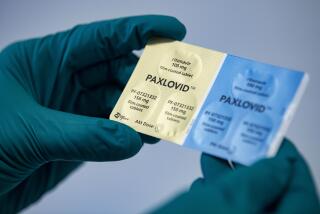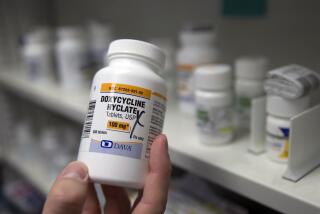Encouraging News From AIDS Front
- Share via
AIDS was in the news last week as researchers presented a flurry of papers at the Interscience Conference on Antimicrobial Agents and Chemotherapy in Toronto. Most of the reports reinforced the optimism that has arisen in the past 18 months about the value of combination therapy in fighting the disease, but researchers injected a strong note of caution.
A report from UC San Francisco researchers confirmed a primary fear among AIDS researchers that patients who skip doses of their complicated drug regimens are more likely to develop relapses characterized by resistance of the virus to the drugs.
Dr. Steven Deeks and his colleagues studied 136 patients who began triple therapy--a combination of two nucleoside analogues and a protease inhibitor--at the university’s AIDS clinic in March 1996. Most patients showed an immediate response, with the amount of the AIDS virus in their blood dropping to undetectable levels.
Now, however, the virus is again detectable--albeit at low levels--in the blood of 53% of the patients. None have developed full-blown AIDS, though, and the researchers are not sure about the consequences of the rise in viral levels.
The triple therapy involves taking as many as 20 pills a day at precise times. Researchers speculate that patients at the AIDS clinic, most of whom were still healthy when they began the therapy, may have been more lax in following their treatment regimens than the much sicker AIDS patients in clinical trials.
*
Some help may be on the way for patients who must take large numbers of pills each day. The U.S. Food and Drug Administration last week approved the first pill that combines two AIDS drugs used in triple therapy: the oldest anti-HIV drug, AZT, as well as lamivudine, also known as 3TC.
Patients previously taking eight tablets of the two drugs per day can now take just two of the new drug, called Combivir. It is manufactured by Glaxo Wellcome.
*
The powerful drug cocktails used to combat HIV in adults should be used to fight HIV in children, a government-sponsored panel recommended at the conference. Donna Shalala, secretary of the Department of Health and Human Services, announced draft guidelines, which are subject to a 30-day public comment period. A group of 64 pediatric AIDS experts developed the guidelines.
A spokeswoman for the department said this is the first time the agency has issued AIDS treatment guidelines for children. The guidelines call for using triple therapy in all HIV-infected babies under 12 months of age as soon as doctors have a confirmed diagnosis. Recently, the FDA approved two protease inhibitors--ritonavir and nelfinavir--that are specifically formulated for children.
The health department team found that, by using sensitive viral tests, HIV can be detected in most infected newborns by 1 month of age and infection in virtually all babies can be diagnosed by 6 months.
*
A triple cocktail using the newest class of AIDS drugs reduced the HIV virus to undetectable levels in more than half of patients, Italian researchers said.
The combination of nevirapine--a non-nucleoside reverse transcriptase inhibitor--with the older AIDS drugs AZT and ddI (didanosine) also boosted immune system levels, the researchers said.
Most forms of triple therapy use a protease inhibitor in combination with drugs such as AZT and ddI. The new results suggest that an alternative will be available for patients who develop resistance to the protease inhibitors.
*
About 275,000 Americans are unaware they are infected with the AIDS virus and are thus not benefiting from early treatment, according to new data released by the national Centers for Disease Control and Prevention. Doctors believe that the sooner treatment starts the better the chance of controlling the disease.
The CDC research is the first serious attempt to calculate how many people in the United States with the AIDS virus know their HIV status. Until now, many believed that about half of all infected people are aware they carry the virus.
An estimated 775,000 Americans are thought to be infected, and the latest figures suggest that about two-thirds of them, or 500,000, already know it.
“This is encouraging, because it suggests that the majority of persons with HIV have been tested,” said Dr. Patricia Sweeney, who directed the study.






